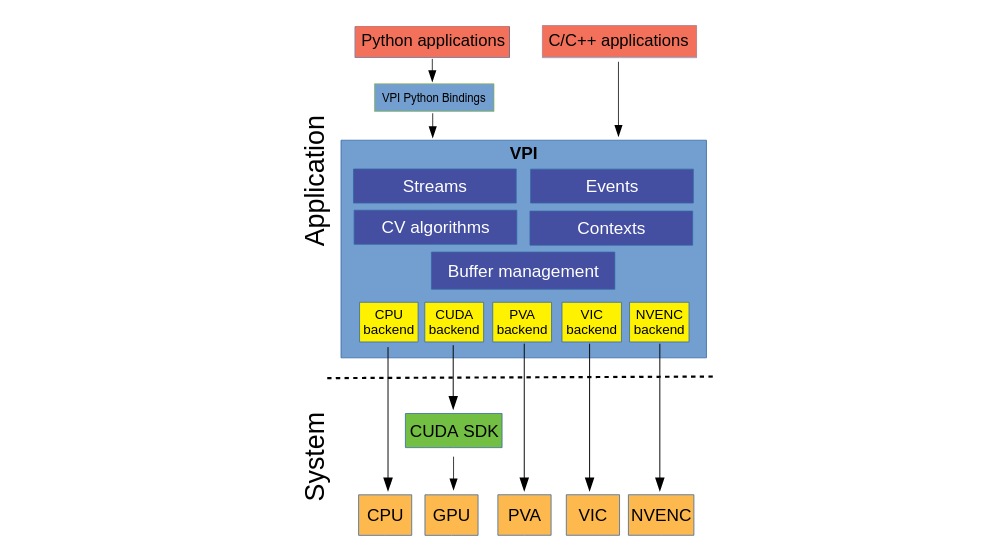Vision Programming Interface (VPI)
Kajanan mentioned this to me. It’s like a better CUDA accelerated OpenCV. However, there is also CV-CUDA.
Installation
sudo apt install nvidia-vpi
- Will be installed at
/opt/nvidia/vpi2
For some reason, it didn’t fully install. Do
sudo apt install libnvvpi2 vpi2-dev vpi2-samples
NOTE: Always reference VPI’s official documentation. My stuff is easily outdated.
Resources
https://www.youtube.com/watch?v=6-FhpfwBpXk&ab_channel=NVIDIADeveloper

Questions:
- I have some confusion about streams. Why do we have to specify the backend for the stream when we do
vpiCreateStreamWrapper, but notvpiStreamCreate. Why the difference? - In
cudaMalloc, you can specify the stream. However,vpiImageCreatedoesn’t require you to define the stream?
Basics
Allocating a VPIImage
CHECK_STATUS(vpiImageCreate(cols, rows, VPI_IMAGE_FORMAT_U8, 0, &image));Free a VPIImage
vpiImageDestroy(image);Few ways to create images
vpiImageCreatevpiImageCreateWrapper(from wrapping VPIImage around some other data)vpiImageLockData/vpiImageUnlock(for getting the raw pointer from VPI, wrap this around another data structure)
VPIImageFormats
I realize that an image format is tightly coupled with how it is stored in memory. So what are the different formats?
The higher level thing is this
/** Represents the available methods to access image contents.
* The correct method depends on \ref VPIImageData::bufferType. */
typedef union VPIImageBufferRec
{
/** Image stored in pitch-linear layout.
* To be used when \ref VPIImageData::bufferType is:
* - \ref VPI_IMAGE_BUFFER_HOST_PITCH_LINEAR
* - \ref VPI_IMAGE_BUFFER_CUDA_PITCH_LINEAR
*/
VPIImageBufferPitchLinear pitch;
/** Image stored in a `cudaArray_t`.
* To be used when \ref VPIImageData::bufferType is:
* - \ref VPI_IMAGE_BUFFER_CUDA_ARRAY
*/
cudaArray_t cudaarray;
/** Image stored as an EGLImageKHR.
* To be used when \ref VPIImageData::bufferType is:
* - \ref VPI_IMAGE_BUFFER_EGLIMAGE
*/
EGLImageKHR egl;
/** Image stored as an NvBuffer file descriptor.
* To be used when \ref VPIImageData::bufferType is:
* - \ref VPI_IMAGE_BUFFER_NVBUFFER
*/
int fd;
} VPIImageBuffer;https://docs.nvidia.com/vpi/group__VPI__Image.html#unionVPIImageBuffer https://docs.nvidia.com/vpi/group__VPI__ImageFormat.html
So for grayscale, they only have 1 channel
#define VPI_IMAGE_FORMAT_U8 VPI_DETAIL_MAKE_NONCOLOR_FMT1(PL, UNSIGNED, X000, X8)
#define VPI_IMAGE_FORMAT_U8_BL VPI_DETAIL_MAKE_NONCOLOR_FMT1(BL, UNSIGNED, X000, X8)
They have something like NV12
#define VPI_IMAGE_FORMAT_NV12 VPI_DETAIL_MAKE_YCbCr_FMT2(BT601, 420, PL, UNSIGNED, XYZ0, X8, X8_Y8)
#define VPI_IMAGE_FORMAT_NV12_ER_BL VPI_DETAIL_MAKE_YCbCr_FMT2(BT601_ER, 420, BL, UNSIGNED, XYZ0, X8, X8_Y8)
VPI Backends
The backends: https://docs.nvidia.com/vpi/architecture.html#arch_backend
- VPI_BACKEND_CPU: Utilizes the CPU for processing
- VPI_BACKEND_CUDA: Leverages NVIDIA’s CUDA technology for GPU processing
- VPI_BACKEND_PVA: PVA (Parallel Vector Architecture) backend, optimized for vectorized operations
- VPI_BACKEND_VIC: VIC (Video Image Compositor) backend, used for image compositing tasks
- VPI_BACKEND_NVENC: NVENC backend, focuses on video encoding using NVIDIA’s hardware acceleration
- VPI_BACKEND_OFA: OFA backend, specific purpose not clearly defined
- VPI_BACKEND_INVALID: Represents an invalid or unspecified backend
Read this, really good example of how you can split into different streams: